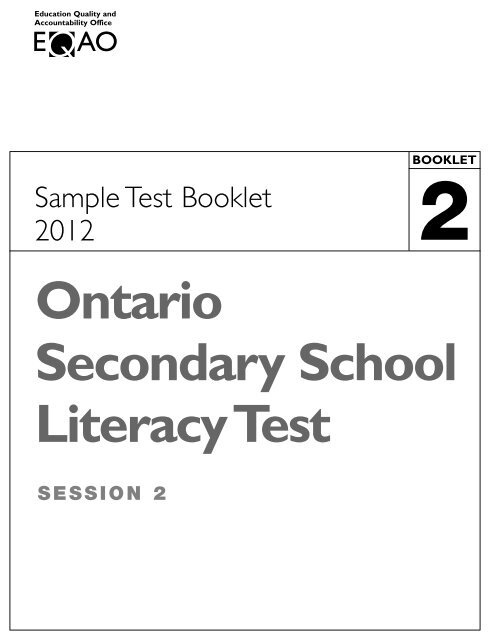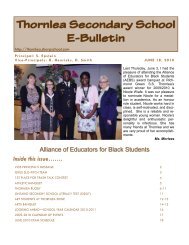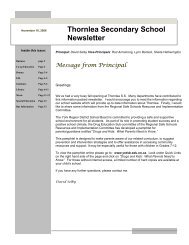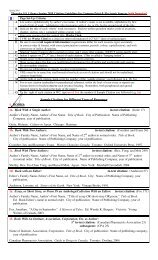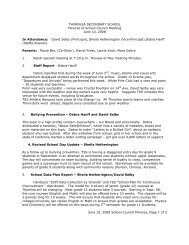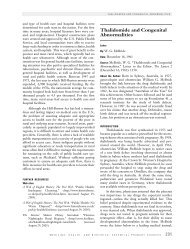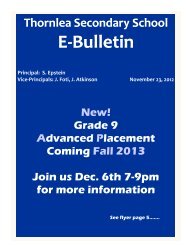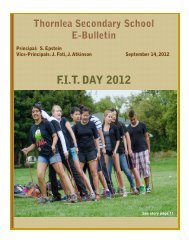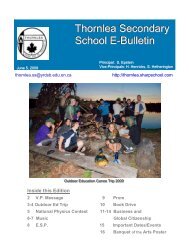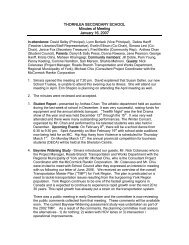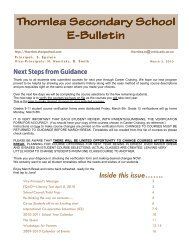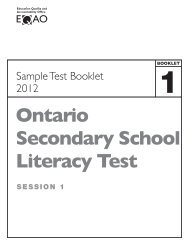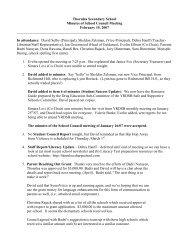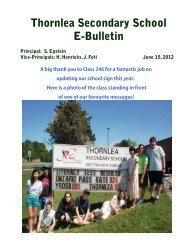OSSLT Sample Test Booklet 2 2012.pdf - Thornlea
OSSLT Sample Test Booklet 2 2012.pdf - Thornlea
OSSLT Sample Test Booklet 2 2012.pdf - Thornlea
- No tags were found...
Create successful ePaper yourself
Turn your PDF publications into a flip-book with our unique Google optimized e-Paper software.
Ontario Secondary School Literacy <strong>Test</strong>Read carefully before writing the test:• Check the identification numbers of your three documents to see that the final 12 digits allmatch. If they do not, report the problem to the teacher in charge.• Check the pages of this <strong>Test</strong> <strong>Booklet</strong> to see that they are in order. If they are not, report theproblem to the teacher in charge.• Read all instructions before responding to the questions.• Use only pencil or blue or black pen in the <strong>Test</strong> <strong>Booklet</strong> and on the Student Answer Sheet.• Attempt all questions. If you leave a question blank, the question will be scored zero.Multiple-Choice• Choose the best or most correct answer for each question.• You must record your multiple-choice answers on the Student Answer Sheet. Multiple-choiceanswers recorded in the <strong>Test</strong> <strong>Booklet</strong> will not be scored.To indicate your answer, fill in the circle completely, as shown below.Like this:Not like this:• If you fill in more than one circle for a question, the question will be scored incorrect.• If you wish to change a multiple-choice answer, erase or cross out your answer and fill in thecircle for your new answer. Ensure that your final answer is clear.Written Answers• For all questions that ask for a written answer, write legibly on the lined space providedin the <strong>Test</strong> <strong>Booklet</strong>.• For the writing sections, pay attention to clarity, organization, spelling, grammar andpunctuation.• The lined space provided for your written work indicates the approximate length of thewriting expected.• There is space in the <strong>Test</strong> <strong>Booklet</strong> for rough notes. Nothing you write in these spaces willbe scored.You are now ready to start <strong>Test</strong> <strong>Booklet</strong> 2: Session 2.Remember to record all your multiple-choice answers on the Student Answer Sheet.<strong>Sample</strong> <strong>Test</strong> <strong>Booklet</strong>: Session 2
Ontario Secondary School Literacy <strong>Test</strong>Session 2
Section G: WritingOntario Secondary School Literacy <strong>Test</strong>Writing a Series of Paragraphs1Task:Purpose andAudience:Length:Topic:Write a minimum of three paragraphs expressing an opinion on thetopic below. Develop your main idea with supporting details(proof, facts, examples, etc.).an adult who is interested in your opinionThe lined space provided for your written work indicates the approximatelength of the writing expected.Should zoos exist?Write your series of paragraphs on the lines provided on the following two pages.Rough NotesUse the space below for rough notes. Nothing you write in this space will be scored.2 <strong>Sample</strong> <strong>Test</strong> <strong>Booklet</strong>: Session 2
Ontario Secondary School Literacy <strong>Test</strong>Section G: WritingShould zoos exist?Continue writing your series of paragraphs on the next page.<strong>Sample</strong> <strong>Test</strong> <strong>Booklet</strong>: Session 2 3
Section G: WritingOntario Secondary School Literacy <strong>Test</strong>End of Section G. Continue to Section H.4 <strong>Sample</strong> <strong>Test</strong> <strong>Booklet</strong>: Session 2
Ontario Secondary School Literacy <strong>Test</strong>Section H: WritingMultiple-Choice (Record the best or most correct answer on the Student Answer Sheet.)1 Which sentence does not belong in theparagraph?(1) A part-time job benefits young people.(2) It gives them job skills and teaches themresponsibility. (3) A part-time job helps themdecide on their future careers. (4) Many retiredpeople take part-time jobs as well. (5) Part-timework is a great way to prepare for the future.A sentence 2B sentence 3C sentence 4D sentence 54 Choose the sentence that is written correctly.FGOur cars axle broke.We had it towed to Daves Garage.H Many car’s were waiting for service.JWe were told it would be an hour’swait.2 Which revision will improve the organizationof the following paragraph?(1) You should follow these suggestions if youwant to be a successful hockey goalie. (2) Beforestepping on the ice, make sure you have safeequipment. (3) Also, you should always stretchbefore you start to play. (4) During the game,keep your eye on the puck. (5) Maintain aposition that will block the net from oncomingshots. (6) These tips will ensure you have apositive goaltending experience.F Remove “Also” from sentence 3.GDivide sentence 2 into two sentences.H Combine the ideas of sentences 4 and 5.JAdd “Next” to the beginning ofsentence 6.3 Choose the sentence that is written correctly.ABCMe, Raj, and Mo plan to go to the movies.My teacher gave the homework to Dennaand I.Michael and me walked up the hill withour skis.D Sakinah and I collected leaves for the fallfestival.End of Section H. Continue to Section I.<strong>Sample</strong> <strong>Test</strong> <strong>Booklet</strong>: Session 2 5
Section I: ReadingOntario Secondary School Literacy <strong>Test</strong>Multiple-Choice (Record the best or most correct answer on the Student Answer Sheet.)1 What is the main purpose of the selection?ABCto show that Sikh-Canadians shouldlearn more about World War Ito show that the role of Sikhs in thedevelopment of Canada is significantto show that Sikh-Canadiancontributions to national developmentare well-knownD to show that Canada’s immigrationpolicy a century ago limitedopportunities for Sikhs2 What does the dash after the date in paragraph 2introduce?FGan important facta change of thoughtH a shift in time frameJa summary of information3 Which word is closest in meaning to“bestowed upon” as used in paragraph 4?ABCfound oncreated byawarded toD taken from4 How does paragraph 5 contribute to thisselection?FGIt explains how Brar started his search.It provides information on Singh’sdeath.H It describes how Singh received hismedal.JIt emphasizes the importance of Brar’sfind.5 In what country did Singh get tuberculosis?ABCIndiaFranceCanadaD England6 How does paragraph 8 contribute to theselection?FGIt provides answers to the mystery.It suggests that there is more toinvestigate.H It confirms that Private Singh was aCanadian.JIt emphasizes the efficiency of Brar’sresearch.7 How has Sandeep Singh Brar kept thememory of Private Buckam Singh alive?ABCby creating a Web siteby presenting a medalby erecting a tombstoneD by writing a newspaper report8 What does Brar’s story show about ahistorian’s work?FGResearch requires persistence.Amateurs lack effective research skills.H Newspapers provide unreliableinformation.JMilitary records are available toprofessionals.8 <strong>Sample</strong> <strong>Test</strong> <strong>Booklet</strong>: Session 2
Section J: ReadingOntario Secondary School Literacy <strong>Test</strong>Read the selection below and answer the questions that follow it.“Thanks for coming,” Eric said, shaking hands with the town councillor.“I’m curious about the ideas in your intriguing letter.” Mr. Hanson nodded toward theparking lot near where they stood. “Please tell me more.”Eric took a deep breath. “Ever since the school closed two years ago, this area hasdeteriorated. But if we clean up the litter and repair the fence, it will be a great place for askateboard park.”Mr. Hanson scanned the broken concrete, nodding. “The old school is being converted intoa community arts centre. This area could become a vital part of the neighbourhood again.”“Here’s a picture of a skateboard park inanother town. Look how busy it is.” Ericwas relieved that the communityrepresentative seemed receptive to the idea.Mr. Hanson studied the photograph, thenasked, “If town council provides the money,how will you and your friends contribute?”Eric felt optimistic now. “We’ll helpdesign and build the ramps. Moreexperienced boarders could give lessons to raise money!” Eric’s voice was enthusiastic.“We’ll still need parking spaces, and the neighbours will not like late-night noise. Theymight worry about vandalism and—”“The skateboard park would use only the back corner, which isn’t near any houses. Sinceyoung people already hang out here, why not give them something fun and physicallyactive to do in their free time?”The furrows of Mr. Hanson’s brow unwrinkled, and Eric’s hopes rose again. “If everyoneworks together,” Eric thought, “maybe this idea will become reality.”12345678910Written for EQAO.10 <strong>Sample</strong> <strong>Test</strong> <strong>Booklet</strong>: Session 2
Ontario Secondary School Literacy <strong>Test</strong>Section J: ReadingMultiple-Choice (Record the best or most correct answer on the Student Answer Sheet.)1 What does “it” refer to in paragraph 3?ABCthe schoolthe parking lotthe community centreD the neighbouring community2 Which word is closest in meaning to“converted” (paragraph 4)?FGbuiltrestoredH replacedJmodified3 Why does Eric show the photo to Mr. Hansonin paragraph 5?ABCto show him the contrast between areasto show him the amount of space neededto suggest a park could be made cheaplyD to illustrate the popularity ofskateboarding5 What would be most persuasive to thetown council in its decision about theskateboard park?ABCthe cost of personal safety equipmentthe floor plan of the converted artscentrea letter of support from a localhomeownerD a demonstration by a national skateboardchampionTurn the page to complete this section.4 Which two paragraphs express a problemand its solution?F 1 and 2G 4 and 5H 6 and 7J 9 and 10<strong>Sample</strong> <strong>Test</strong> <strong>Booklet</strong>: Session 2 11
Section J: ReadingOntario Secondary School Literacy <strong>Test</strong>Written Answer6 Identify one skill that Eric uses to promote the skateboard park. Use specific details from the selectionto support your answer.7 Identify an example of how Mr. Hanson represents his community. Use specific details from theselection to support your answer.Rough NotesUse the space below for rough notes. Nothing you write in this space will be scored.End of Section J. Continue to Section K.12 <strong>Sample</strong> <strong>Test</strong> <strong>Booklet</strong>: Session 2
Section L: ReadingOntario Secondary School Literacy <strong>Test</strong>Read the selection below and answer the questions that follow it.© Susie Mah/Sun Media. Graphic and Research: Susie Mah © Sun Media Corp. Reprinted with permission.14 <strong>Sample</strong> <strong>Test</strong> <strong>Booklet</strong>: Session 2
Ontario Secondary School Literacy <strong>Test</strong>Section L: ReadingMultiple-Choice (Record the best or most correct answer on the Student Answer Sheet.)1 Which combination of factors contributesmost to the creation of a pothole?ABCheavy rain and loose soilfreezing water and busy trafficsnow tires and pavement cracksD worn asphalt and temporary repairs6 What does the photograph in the middle ofthe page show?FGa repaired potholehow to fix a potholeH another view of Stage 7Jthe early stages of pothole formation2 What does the word “void” (Stage 5) mean?FGfreezing wateran empty spaceH cracked pavementJa crumbled sub-base3 What remains unchanged as a pothole isformed and fixed?ABCthe soilthe sub-basethe pavementD the temperature4 Which feature in this graphic text identifiesthe problem and its solution?FGphotosarrowsH subtitlesJnumbers5 How is the information in the first bulletunder “How They’re Fixed” organized?ABCby cause and effectas steps in a sequencein order of importanceD by comparing and contrastingEnd of Section L. Continue to Section M.<strong>Sample</strong> <strong>Test</strong> <strong>Booklet</strong>: Session 2 15
Section M: Student QuestionnaireOntario Secondary School Literacy <strong>Test</strong>Background Information (Record your answers on the Student Answer Sheet.)We need to know about your background, so we can see how students with different experiences do onthe test. All responses will be summarized and reported at the school, board and provincial levels.Read each question carefully. If no answer seems exactly right, fill in the circle on the Student AnswerSheet with the response closest to what you want to say.Language Background1 a) Is English the first language you learned athome?Y YesN Nob) What languages do you speak at home(choose one only)?AOnly or mostly EnglishBAnother language (or languages) asoften as EnglishCOnly or mostly another language(or other languages)Home Computer Use2 Indicate how often you use a computer at homefor homework (choose one only).AI don’t have a computer at home.BI never or hardly ever use the computerfor homework.CI use the computer once or twice a monthfor homework.D I use the computer once or twice a weekfor homework.EI use the computer almost every day forhomework.Reading3 Indicate the types of materials you read inEnglish outside school most weeks.a) Non-fiction books, e.g., biographiesY YesN Nob) ComicsY YesN Noc) Web sites, e-mail, chat messagesY YesN Nod) LettersY YesN Noe) MagazinesY YesN Nof) Manuals, instructionsY YesN Nog) NewspapersY YesN Noh) Novels, fiction, short storiesY YesN Noi) Song lyrics, poemsY YesN Noj) Religious or spiritual writingsY YesN No4 Indicate the number of hours a week you readmaterials written in English outside school, notincluding your homework (choose one only).AOne hour or lessBMore than one hour but less than threehoursCMore than three hours but less than fivehoursD Five hours or more16 <strong>Sample</strong> <strong>Test</strong> <strong>Booklet</strong>: Session 2
Ontario Secondary School Literacy <strong>Test</strong>Section M: Student Questionnaire5 Indicate what English-language materials youhave at home.a) Dictionaries, encyclopedias (print orelectronic)Y Yes N Nob) BooksY YesN Noc) NewspapersY Yes N Nod) MagazinesY Yes N No7 Indicate the number of hours a week you writein English outside school, not including yourhomework (choose one only).ABCOne hour or lessMore than one hour but less than threehoursMore than three hours but less than fivehoursD Five hours or moreWriting6 Indicate the types of writing you do in Englishoutside school most weeks.a) E-mail, chat messagesY Yes N Nob) Letters, journals, diariesY Yes N Noc) Notes, directions, instructionsY Yes N Nod) Song lyrics, poemsY Yes N Noe) Stories, fictionY Yes N Nof) Work-related writingY Yes N NoEnd of <strong>Booklet</strong> 2.<strong>Sample</strong> <strong>Test</strong> <strong>Booklet</strong>: Session 2 17
© 2012 Queen’s Printer for OntarioEducation Quality and Accountability Office2 Carlton Street, Suite 1200Toronto, Ontario M5B 2M9Telephone: 1-888-327-7377Web site: www.eqao.com


